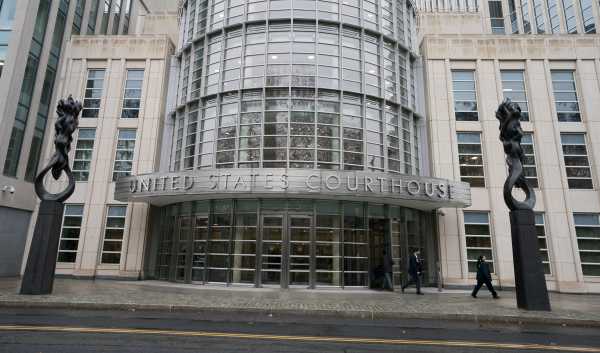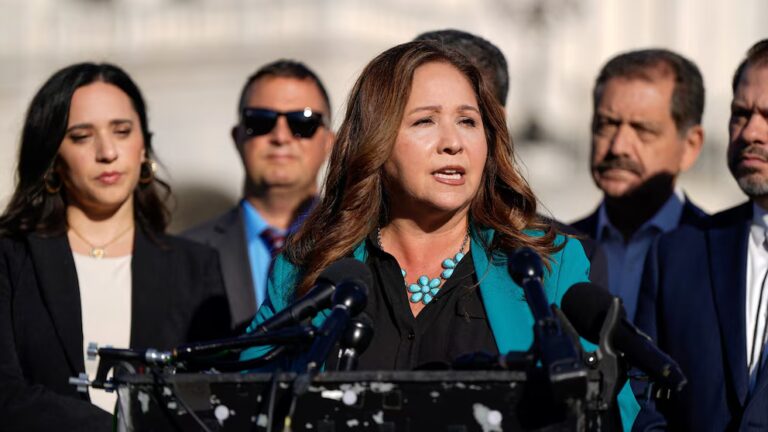
In the past year, women have been coming forward in the press, rather than the courts, to accuse men of sexual harassment. And here’s why: The legal system that’s supposed to investigate, address, and prevent sexual harassment has failed them for decades.
That’s the conclusion from a review of more than 1,000 job discrimination cases by two law professors: Sandra Sperino at the University of Cincinnati, and Suja Thomas at the University of Illinois. Sperino and Thomas set out to understand how judges view discrimination cases. Their results are summarized in their new book, Unequal: How American Courts Undermine Discrimination Law.
Sexual harassment is illegal in all workplaces and in every state. It’s a form of gender discrimination prohibited by the Civil Rights Act of 1964, and it’s illegal whether the alleged perpetrator is a person’s co-worker or supervisor.
But Sperino and Thomas argue that federal court judges frequently dismiss sexual harassment cases that likely meet the requirements under the law.
In the past 40 years, they say federal judges across the country (who are mostly men) have developed an extremely narrow interpretation of what sexual harassment is under the law, and which behaviors create a hostile work environment. Repeated groping, sexual propositions, and sexualized comments at work usually don’t meet that high standard.
“It’s shocking,” said Sperino. “You read about women being groped or rubbed against a lot at work, and judges don’t think that creates a hostile work environment.”
The federal courts have repeatedly dismissed women’s well-documented claims of sexual harassment at work —the same kinds of alleged actions that have surfaced in media reports in recent weeks.
That helps explain why less than 2 percent of job discrimination lawsuits — a category that includes sexual harassment — make it to a jury, and why only about 4 percent end up awarding damages to victims.
Many claims never make it to court
The roadblocks to getting justice start with an unusually complicated and strict process to file a complaint against an employer in the first place.
Employees who think their employer has discriminated against them — including through sexual harassment, which is legally considered sex-based discrimination — have to start by filing a complaint with the US Equal Employment Opportunity Commission, which enforces federal civil rights laws.
Requiring people to go through an administrative agency before filing a lawsuit is highly unusual. In most civil cases, including personal injury or negligence claims, anyone can file a lawsuit in court at any time. Congress also placed a strict time frame on when employees can file job discrimination complaints with the EEOC: no later than 300 days after the alleged discrimination happened. Then the agency has six months to review the case before an employee can sue in court. Once the EEOC gives an employee a Right to Sue notice, they have three months to file a lawsuit.
During the EEOC’s review of the case, the commission investigates and tries to resolve the dispute through mediation. About half the time, investigators are unable to determine if an employer engaged in sexual harassment, and the EEOC notifies workers that they can sue their employer in court. Sometimes the complaints are settled during this process, and sometimes the EEOC will sue the employer in the most serious cases.
In 2016, for example, the EEOC received 6,758 sexual harassment claims, and resolved 23 percent of the cases in favor of employees, adding up to $40 million in relief for workers. In 54 percent of their investigations, EEOC staff was unable to gather enough evidence to determine if harassment occurred. In those cases, employees are given permission to sue in court.
The details of these cases are never made public, unless an employee decides to sue in federal court.
On top of that, a growing number of companies are requiring employees to sign arbitration agreements, which essentially bars workers from suing their employers and instead forces them to resolve disputes privately. So even when the EEOC gives a worker permission to sue, there’s a good chance they can’t because of these agreements.
Those who can sue face a slim chance of any success in federal court.
When victims take their cases to court, the odds are against them
Even if a case gets to court — meaning that the employee went through the six-month EEOC review process and chooses to sue their employer — federal judges dismiss job discrimination claims at a much higher rate than other civil lawsuits.
Only about four out of 100 job discrimination lawsuits that aren’t settled or voluntarily dismissed end up providing any kind of relief for workers, according to Katie Eyer, a law professor at Rutgers.
This is highly unusual in the world of federal litigation, “exceeding the negative outcomes faced by other litigants in both scope and degree,” she wrote in a 2011 Minnesota Law Review Journal article. In other words, the odds are stacked against victims of discrimination more than victims of medical malpractice or consumer fraud, for example.
The high dismissal rates aren’t for lack of evidence. When deciding whether to dismiss a case through summary judgment, a judge needs to determine if a reasonable person would consider the alleged actions to be a violation of the law. More often than not, judges don’t think the behavior is bad enough or persistent enough to be illegal.
Through their repeated dismissals, federal judges have narrowed the definition of illegal sexual harassment so much that a woman (or man) would basically have to accuse her boss of rape to present a clear-cut case of illegal sexual harassment.
Federal judges developed a high bar for illegal harassment
The high courts have defined two forms of sexual harassment that are illegal at work. In both, the behavior must be unwelcome to be against the law.
The first is called quid pro quo harassment. In these scenarios, a person in a position of power demands that a subordinate tolerate harassment (like groping and sexual requests) to keep his or her job, or to get a salary raise or other job benefits. These are the most obvious cases and the easiest to prove. It only has to happen once to be illegal.
The second form of illegal harassment is more subjective. It’s behavior that is “severe or pervasive” enough to create a hostile work environment for the victim. This is open to interpretation, because there is no definition as to what makes harassment (like groping and sexual requests) severe or pervasive enough to create a hostile work environment. Instead, juries and judges are supposed to consider how often the behavior happened, whether it was physical or verbal, whether the perpetrator was a supervisor, whether more than one person participated, and whether a reasonable person would view the behavior as offensive.
The second type of case is the one that federal judges are most likely to dismiss, because they might not think someone’s actions are all that bad. And when one judge decides that a co-worker’s repeated requests for sex don’t count as sexual harassment, and if that dismissal is upheld by an appeals court, it creates a legal rationale for other judges to dismiss similar cases.
This is how federal judges created a high bar for what the courts consider harassment that is “severe and pervasive” enough to create a hostile work environment. If they don’t believe that someone’s allegation rises to the level of severity, then they can dismiss a case before it goes to trial.
More often than not, federal judges do not believe women’s claims meet this standard, said Sperino. This is the main reason so few sexual harassment lawsuits go to trial when they aren’t settled beforehand, she says.
Here are a few cases that federal judges have dismissed in recent decades because they didn’t believe a reasonable person would consider them bad enough to create a hostile work environment. The dismissals were later upheld by the appellate courts, creating legal precedent for other judges to dismiss similar cases.
- In one Alabama case, a woman who worked at Blue Cross Blue Shield said her supervisor told her she only had a job was because they “needed a skirt in the office.” That same supervisor allegedly asked the woman to spend the night with him at a hotel, asked her to “blow” him, constantly called her “babe,” and repeatedly zipped and unzipped his pants in front of her. He also had a habit of referring to women with words like “bitch,” “slut,” and “tramp.” The case was filed and dismissed in the US District Court for the Northern District of Alabama. The dismissal was upheld by the 11th Circuit Court of Appeals in 2007.
- A 911 phone dispatcher for the city of San Mateo, California, said her co-worker touched her stomach and commented on how soft and sexy it was. When she tried to push him away, the co-worker forced his hand underneath her sweater and bra to fondle her breast. He tried again, but stopped when another colleague entered the room. Two other women reported similar harassment from the same employee. The case was filed and dismissed in the US District Court for the Northern District of California. The dismissal was upheld by the Ninth Circuit Court of Appeals in 2000.
- At a Coca-Cola bottling plant in Chicago, a woman said her male supervisor repeatedly asked her out on dates, which she declined. He often asked about her personal life and told her how beautiful she was, put his hand on her shoulders at least six times, placed “I love you” signs on her desk, and tried to kiss her three times. The case was filed and dismissed in the US District Court for the Northern District of Illinois. The dismissal was upheld by the Seventh Circuit Court of Appeals in 1993.
- At a construction site in Alabama, a male electrical worker said his supervisor repeatedly made comments about his genitals, talked about raping him, and asked him to “feel his pipe.” When the worker complained, his supervisor said there was nothing he could do. The supervisor allegedly made multiple sexual comments a day during the 10 days they worked together. After complaining to another supervisor, and then taking a few days off work, the worker was told he no longer had a job. The case was filed and dismissed in the US District Court for the Southern District of Alabama in 2000.
These cases have been cited as the legal reasoning for dismissing later lawsuits describing similar behavior.
Sperino calls this a “domino effect” that has led judges across the country to throw out other similar cases.
“Judges feel compelled to follow these older cases, even though many cases in the ’90s were probably wrongly decided and haven’t aged well,” she said.
For example, when one woman filed a lawsuit alleging that her supervisor fired her after she complained about him slapping her on the butt, a federal judge decided that it wasn’t reasonable for a worker to think that a slap on the butt was harassment. He justified his reasoning by citing another case that was dismissed, in which a supervisor slapped a female employee on the butt multiple times.
A judge’s gender shapes court decisions
One of the factors in play is that the federal bench is overwhelmingly male. In 2016, about two-thirds of federal judges at the trial and appellate court level were male. Twenty years ago, when many sexual harassment cases were first heard, the imbalance was even worse.
This is one reason it’s so hard for victims of sexual harassment to get justice. Research shows that a judge’s gender plays a significant role in the outcome of sexual harassment cases. A Yale Law Journal article analyzed more than 500 sexual harassment case appeals in 1999, 2000, and 2001 and concluded that plaintiffs were twice as likely to win their appeal when a female judge was on the bench.
Men also have a narrower view of sexual harassment, in general, than women. Researchers at the University of Minnesota analyzed 62 studies of how women and men view sexual harassment, and found that women were far more likely to consider a broader range of actions as sexual harassment. Women considered groping and repeated requests for dates to fit the label; men were less likely to think so.
Women were also much more likely to consider dating pressure and physical sexual contact as behavior that creates a hostile work environment. This distinction is important. For a plaintiff to prove they were subjected to illegal harassment, they have to persuade a jury that it created a hostile work environment for them (this is not necessary in the more straightforward quid pro quo harassment cases). So it makes sense that a male judge would be more likely to dismiss a case for not meeting that standard than a female judge.
Yet federal judges are supposed to define “severe and pervasive” sexual harassment the way a “reasonable person” on the jury would, not the way they might view it. That is such a subjective standard. Different people have different views about what is reasonable, just as men and women have different views about what behavior creates a toxic work environment.
Federal judges, who are appointed by the president, are overwhelmingly white, male, and from privileged backgrounds. On the other hand, juries represent a wider range of American society.
“Because of these differences, it is possible for a jury to believe the discrimination did occur, while a federal judge may think that discrimination may not have occurred. These differences make it even more important for these disputed cases to be left to juries,” Sperino and Thomas write.
Juries rarely get that chance. It’s no wonder so many women and men have decided instead to tell their experiences to the press in recent weeks —they have no other option. The justice system has failed to give sexual harassment victims their day in court.
One of these most infamous cases was Paula Jones’s sexual harassment lawsuit against President Bill Clinton. Jones filed the case in federal court in Arkansas, claiming that Clinton made unwanted sexual advances toward her when he was governor of Arkansas and she was a 24-year-old state employee. She said he summoned her to a hotel room, exposed himself, and asked her for oral sex. She rejected his advances, and says she was intimidated and reassigned jobs in retaliation.
The federal judge dismissed the case, saying the allegations “fell short” of illegal behavior.
“While the alleged incident in the hotel, if true, was certainly boorish and offensive,” wrote Judge Susan Wright in her 1998 decision, she found that the alleged conduct was not sexual harassment.
Jones gave a tearful press conference a few days later, saying that she planned to appeal the case.
“I was shocked” by the decision, Jones said, “because I believed what Mr. Clinton did to me was wrong and that the law protects women who are subjected to that kind of abuse of power.”
Clinton and Jones later agreed to settle the case for $850,000.
Sourse: vox.com






